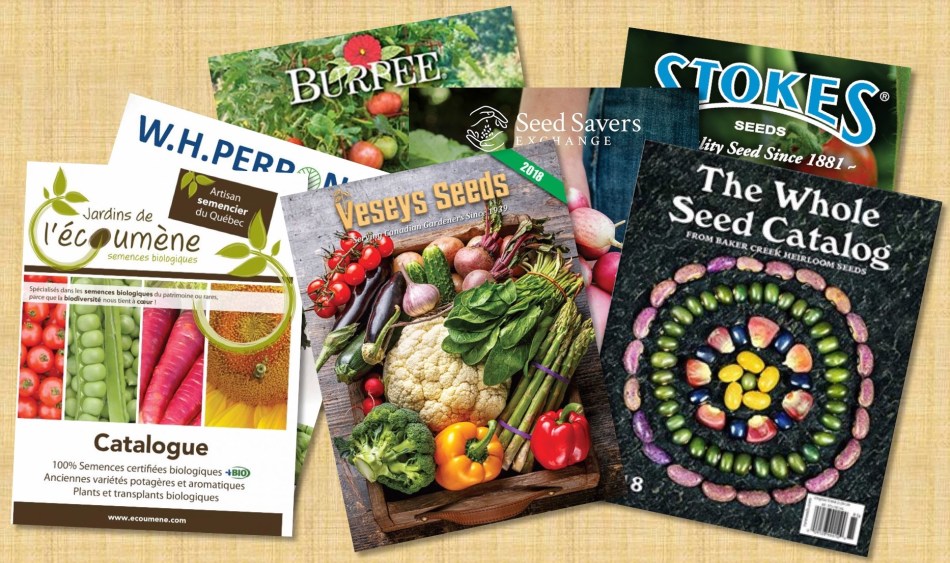
Horticultural catalogs begin to arrive in large numbers at the beginning of the year. Seed catalogs tend to arrive first, then summer bulb and garden tool catalogs a little later, with catalogs covering hardy plants, like perennials, shrubs, and fruit trees, later yet. Essentially, they follow the order of arrival of the material: you need your seeds early to start them indoors, summer bulbs, not quite as early, but still before the weather warms up, as many do need a few weeks head start indoors, while hardy plants won’t even be delivered until there is no frost in the air, so their catalogs are often not available until early spring.
It used to be that all catalogs were printed and sent out by mail, but nowadays, almost all plant catalogs have a web version. What’s more, given the increasing costs of printing and mailing, every year sees fewer printed catalogs as more and more catalogs are on-line only.
Looking Back in Time

Plant and seed catalogs have a long history, dating back to the 18th century. Moreover, until the arrival of garden centers in the 1950s or 1960s, they were often the only source of plants for home gardeners. I remember when fruit trees used to arrive by mail at my father’s farm: small, leafless, bare root trees not even wrapped, but simply delivered loose, with an address label attached to the trunk. They scarcely seemed alive, but believe it or not, they always grew perfectly! Today, however, plants are much better packaged and usually arrive in mint condition. (And if anything is not to your satisfaction, advise the supplier immediately so he can replace it.)

As for ordering seeds, the system has not changed for generations. Unlike live plants, which you have to order within your own country (unless you obtain an import permit from your federal government and a phytosanitary certificate from the supplying nursery … and that greatly increases the cost), you can order seeds from anywhere in the world without a special permit. Your seeds will simply arrive in an envelope or a box (larger orders) that contains the different seed packets, similar to the seed packets seen in garden centers, but generally without color pictures.
21st Century Ordering
Payment is much easier these days than it used to be. Previously you had to pay by check or mail in your credit card information, with the complication that if a plant or a seed were out of stock, the supplier would either have to make adjustments and send a reimbursement for part of your order, offer you credit on future purchases, or send “substitutes” to compensate: not always the varieties you wanted.

Nowadays, the easiest route is to order on-line (even if you use a printed catalog for your research, there’ll be an on-line order form you can fill out). No need for calculations on-line: usually if you enter the plant’s name and the quantity required, you’ll get an automatic total. Sure beats filling in a paper form where errors (mostly yours) are so easy to make! And you can pay instantly by credit card or PayPal and usually get a confirmation within minutes, hours at the most.
I think what I like best about this compared to mail in orders is that you know right away if a product is out of stock (the on-line order form will advise you), allowing you to decide whether you want to order it elsewhere or try a different variety.

I also like the “wish list” option offered by some on-line catalogs. I go blithely through the catalog, adding all the plants I think I want, then do the same with other catalogs. I then pull up all my wish lists (a large screen is very useful!) and start paring down the list. I used to do this on paper, but it was more work.
You can also do this by adding plants to the “shopping cart,” then subtracting the extras later, but a wish list is different: it’s a permanent list in your name you can return to visit in the future. Maybe you don’t want to order the plant this year, but might the next. That suits me perfectly!
Pricey? Not Necessarily
Many beginning gardeners are surprised to learn that the seeds, plants and tools sold by mail often cost less than those offered in garden centers, even when delivery charges are added on. That’s largely because mail-order suppliers don’t need to maintain an expensive store in a heavily taxed commercial zone with dozens of employees. Often they are family businesses run from someone’s spare room or basement, or, at the very least, are way out in the country where taxes are less of a burden! And rather than dying out, the garden catalog business is booming: there has never been so many catalogs or so much choice of plant material!

Catalog Hunting
I’m not going to list catalogs here: there are (1) too many of them and (2) your interests may not be the same as mine. Instead, either ask a gardening friend or your local garden club for a few suggestions of general seed, tool, or plant catalogs … or search on your own on the Web. This is especially interesting if you have a specific group of plants in mind. After all, your favorite local garden center offers maybe 20 different kinds of hosta or 5 or 6 different tomatoes; many on-line suppliers offer 300 or more!
The plant hunting season starts now! Enjoy!![]()
Pingback: January gardening | Strafford County Master Gardeners Association
Thanks for sharing!